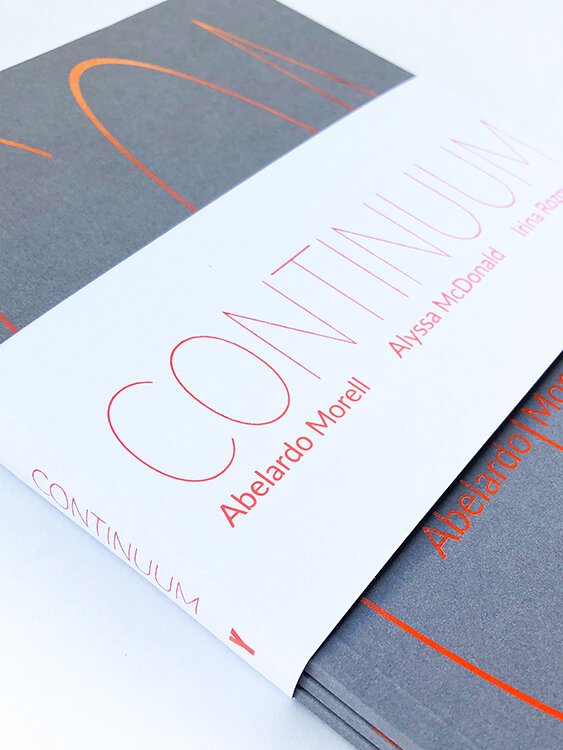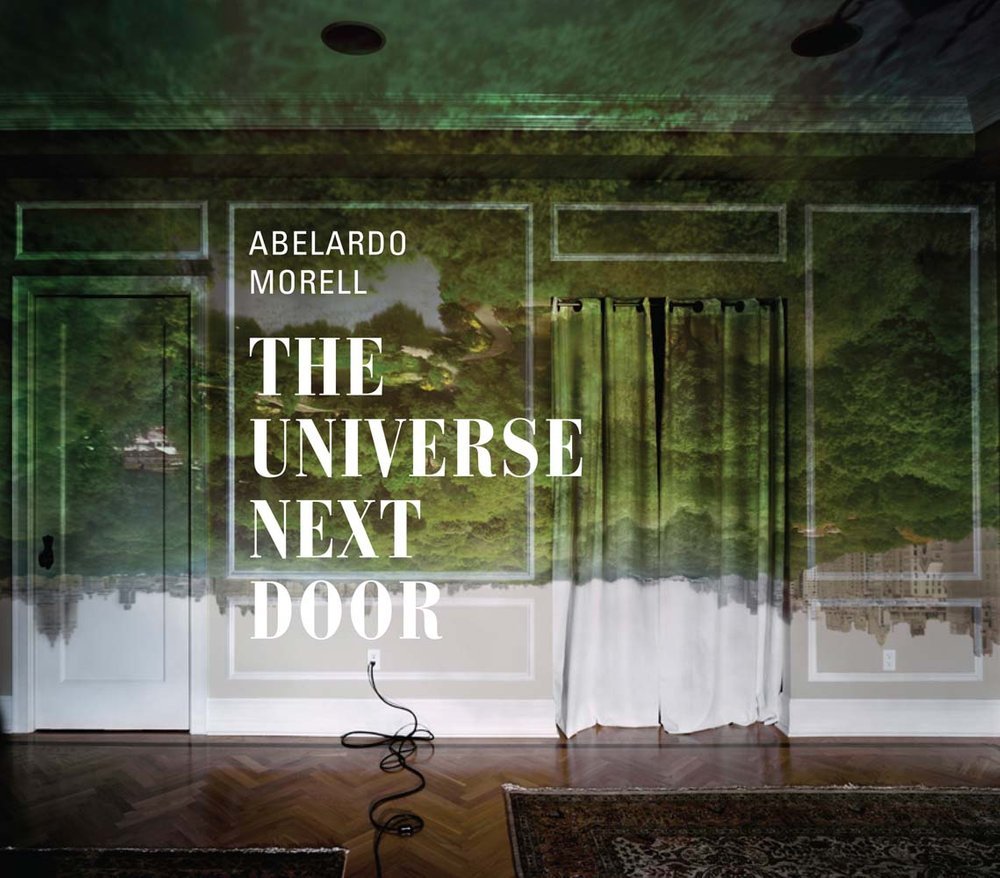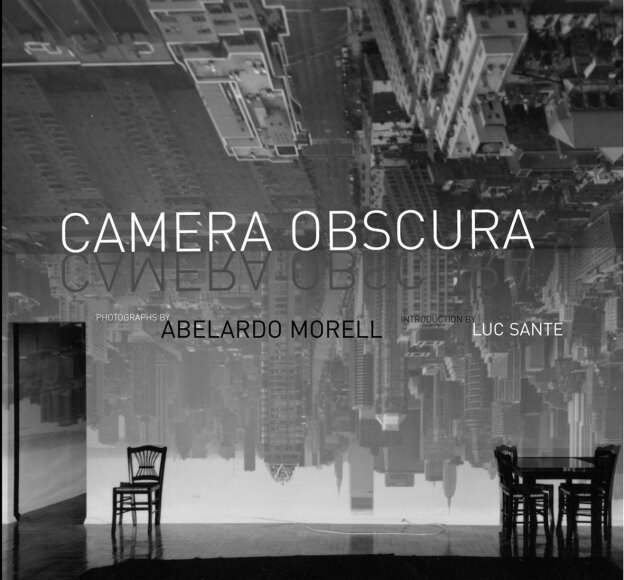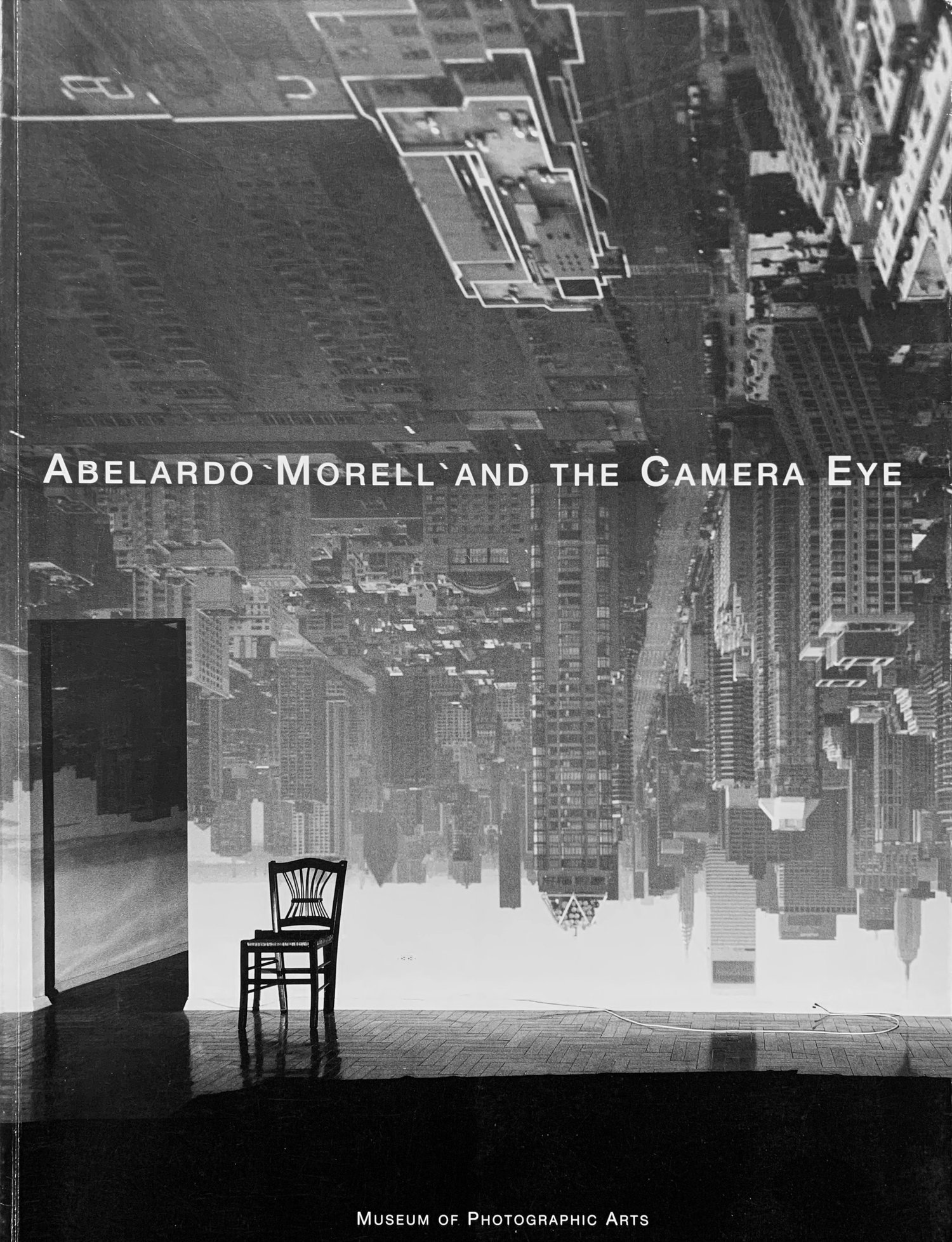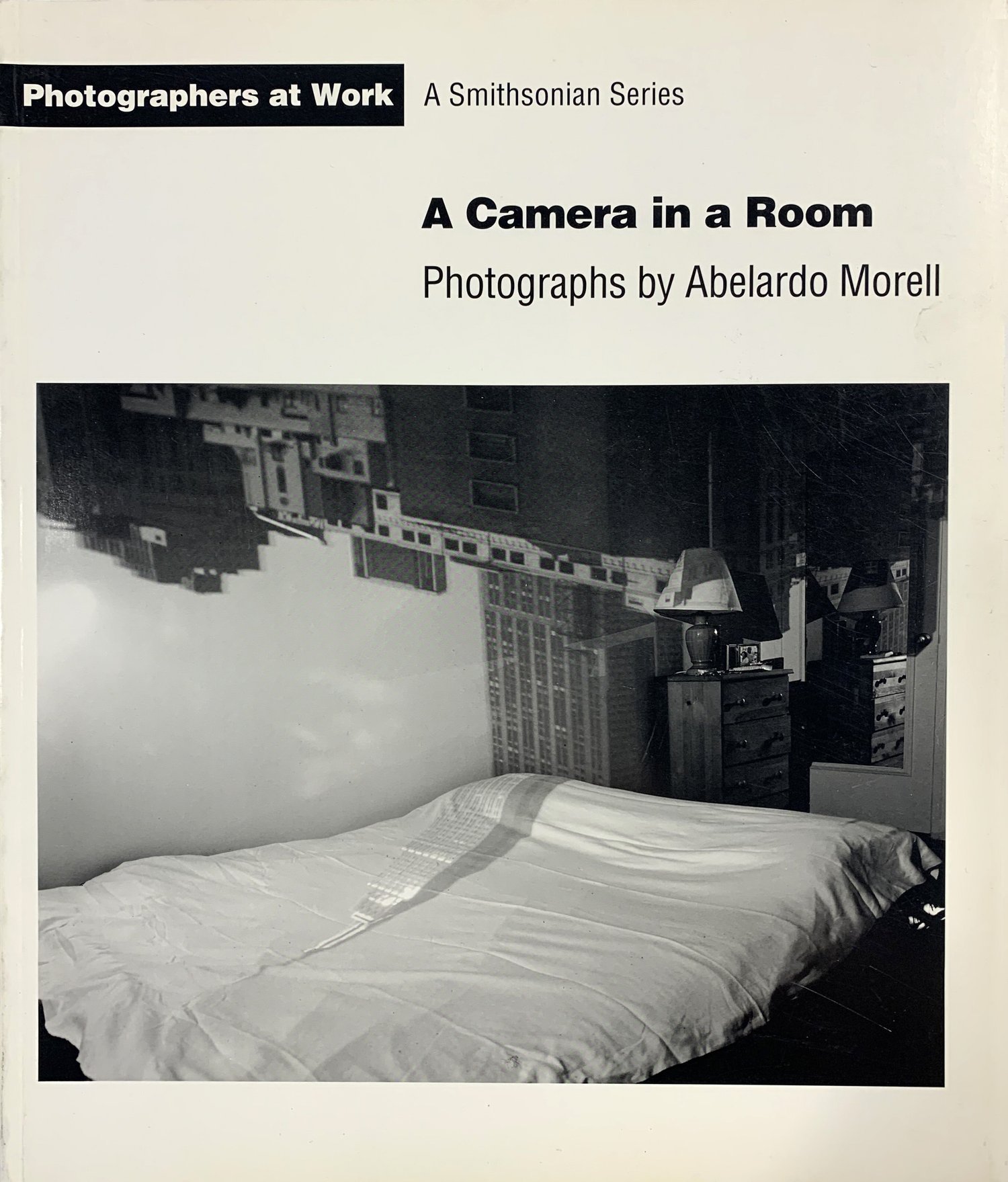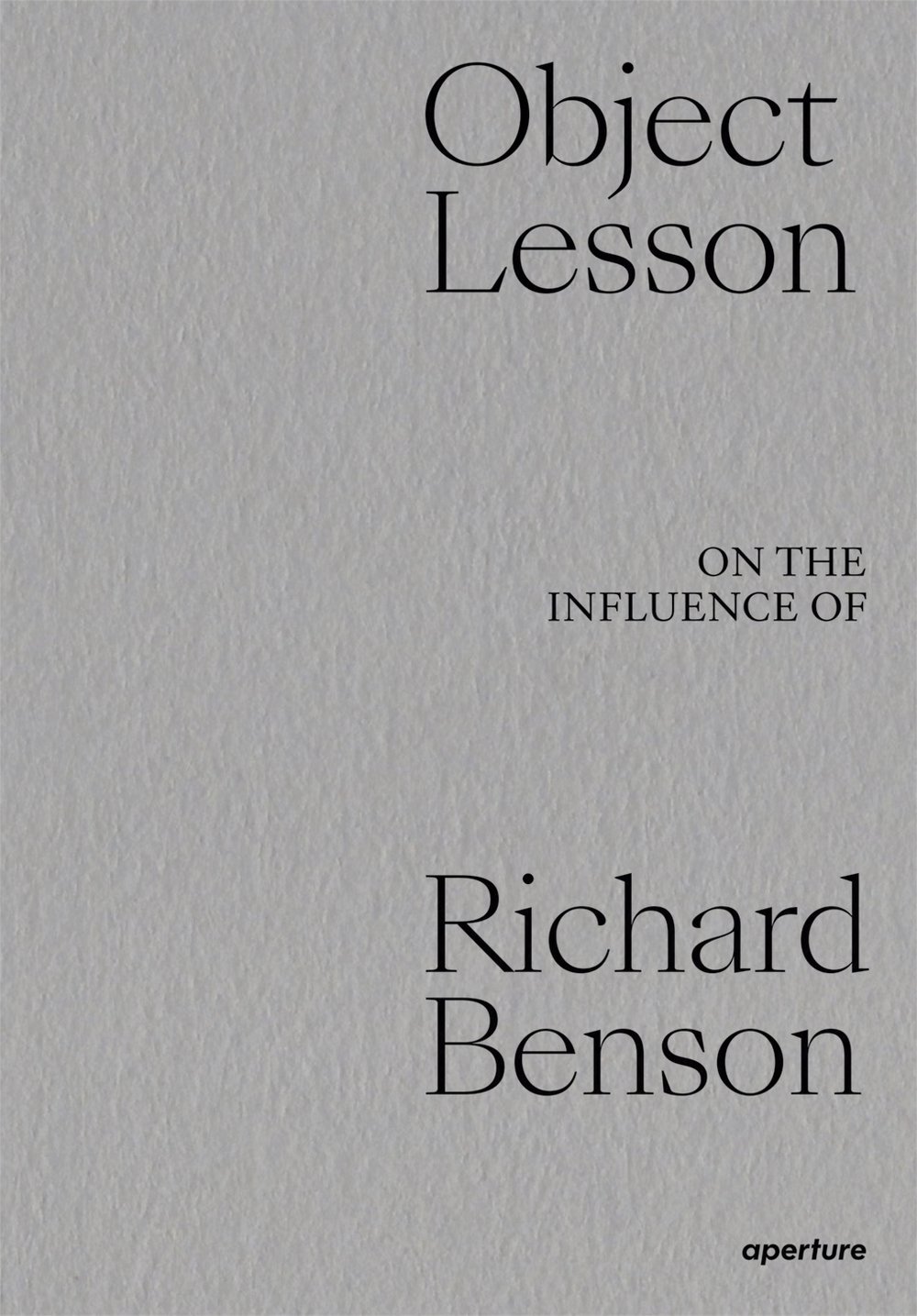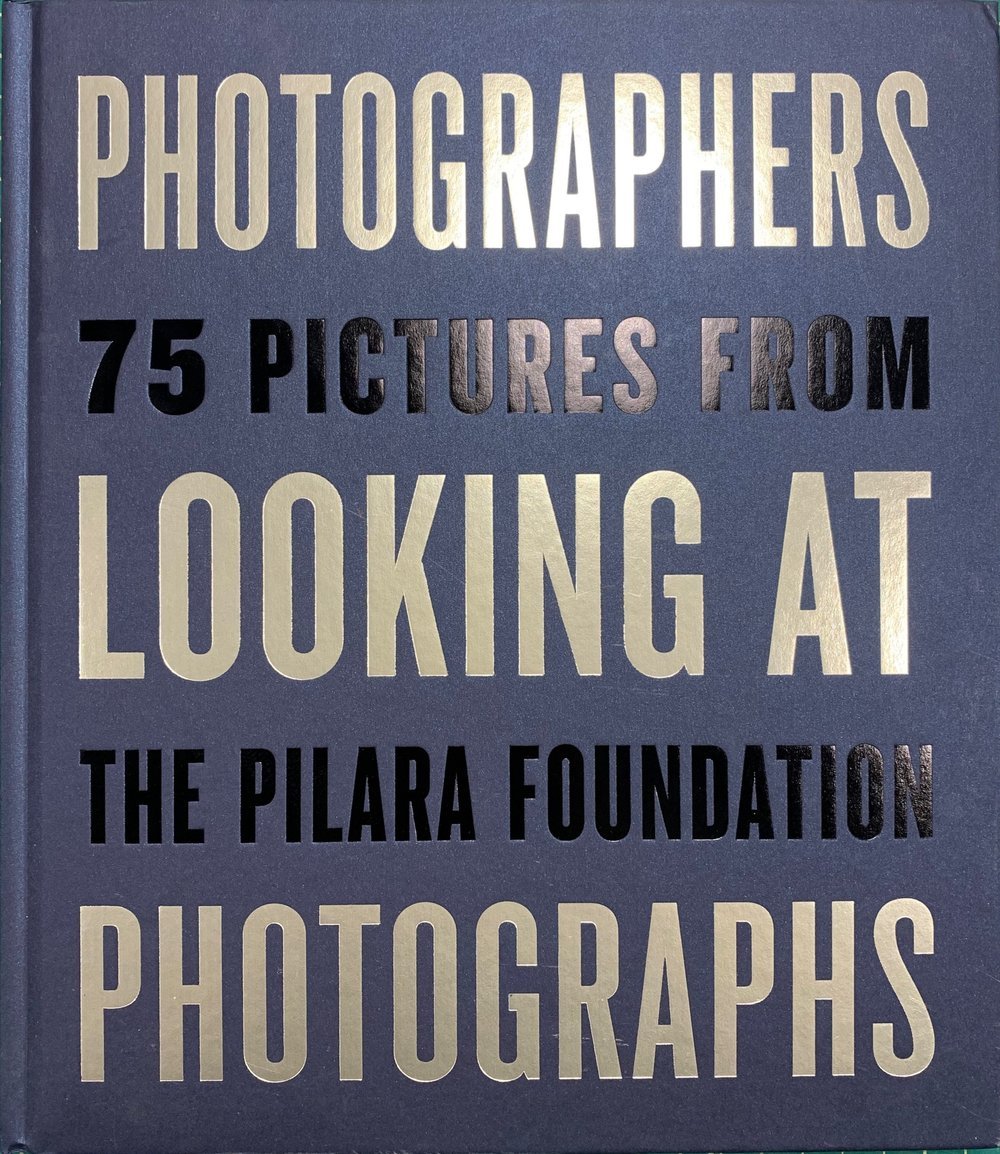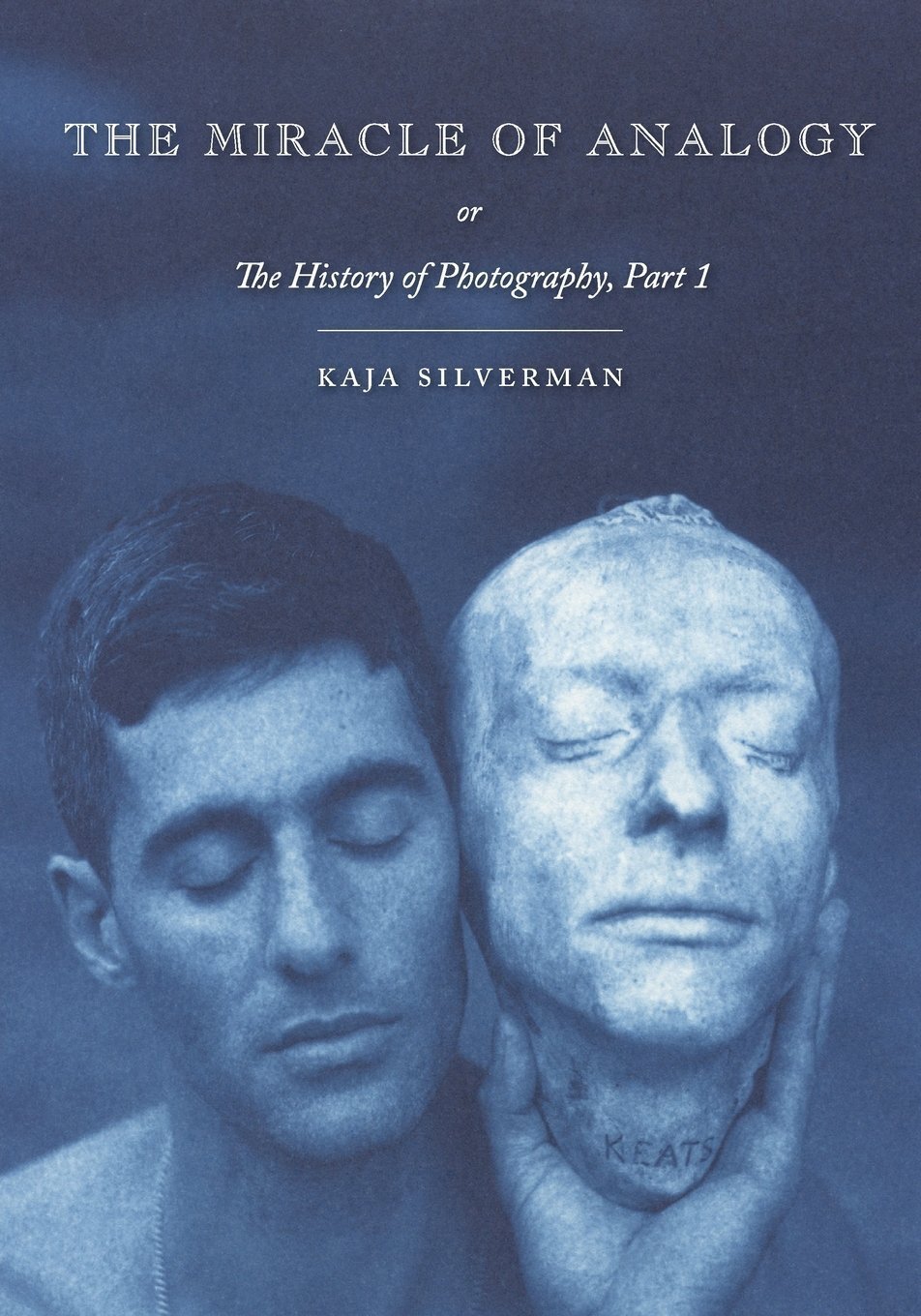Books
Monographs by Abelardo Morell
Tent Camera
Photographs by Abelardo Morell
Nazraeli Press, 2019
-
“We enclose boundless space in a square foot of paper: We pour out deluge from the inch space of the heart.” – Lu Chi (Chinese poet, 261-303)
“I have always loved the 19th Century photographs of the American West by Carleton Watkins, Timothy O’Sullivan and William Henry Jackson but, when I had a commission to photograph these landscapes anew, the work of these men daunted me—so much so that, for a long time, I couldn’t imagine how I would approach making landscape images myself. But like many immigrants, I felt moved to explore the vastness of my adopted country. To picture America’s national parks, I invented a device— part tent, part periscope— to show how the immediacy of the ground we walk on enhances our understanding of the panorama, the larger world it helps to form. I wanted to find a way to make these well-known view of familiar and iconic places into my own private discoveries.” — Abelardo Morell
Flowers for Lisa: A Delirium of Photographic Invention
Photographs by Abelardo Morell
Conversation with Lawrence Weschler
Abrams, October, 2018
-
Best known for his surreal camera obscura pictures and luminous black-and-white photographs of books, photographer Abelardo Morell now turns his transformative lens to one of the most common of artistic subjects, the flower. The concept for Flowers for Lisa emerged when Morell gave his wife, Lisa, a photograph of flowers on her birthday. “Flowers are part of a long tradition of still life in art,” writes Morell. “Precisely because flowers are such a conventional subject, I felt a strong desire to describe them in new, inventive ways.” With nods to the work of Jan Brueghel, Édouard Manet, Georgia O’Keeffe, René Magritte, and others, Morell does just that; the images are as innovative as they are arresting.
-
Lucy Sante on the Year’s Best Photography Books, Lucy Sante, The New York Times, December 4, 2018
His Three Loves: Photography, Art History and Lisa, Lawrence Weschler, The New York Times, November 5, 2018
Notable Photo Books of 2018, PDN Online, Winter, 2018
32 Books that Dropped Our Jaws in 2018, Humble Arts Foundation, Winter, 2018
Continuum
Photographs by Abelardo Morell,
Irina Rozovsky & Alyssa McDonald
Softcover, set of three books
Yoffy Press, 2019
-
Continuum is a part of Yoffy Press’ Triptych series and features Abelardo Morell, Irina Rozovsky and Alyssa McDonald. In each triptych, three artists are given a word to inspire the creation of a small book of work. The books are sold as a set, inviting the viewer to make connections between the projects and overarching theme. Abelardo Morell taught at the Massachusetts College of Art and Design for more than thirty years. Here, Irina Rozovsky was his student and became a teacher herself. Alyssa McDonald became Irina Rozovsky’s student and then Abelardo Morell’s assistant. This publication brings three photographers into focus who have all in some way learned from each other. This continuum is one of many lineages in the unending and ever-changing collective evolution of photography.
The Universe Next Door
Abelardo Morell
Introduction by Elizabeth Siegel
The Art Institute of Chicago, Chicago, 2013
-
Over the past twenty-five years, Abelardo Morell (b. 1948) has earned international praise for his images that use the language of photography to explore visual surprise and wonder. Born in Havana, Cuba, Morell came to the United States as a teenager in 1962 and later studied photography, earning an MFA from Yale University. He gained attention for intimate, black-and-white pictures of domestic objects from a child’s point of view, inspired by the birth of his son in 1986, as well as images in which he turns a room into a giant camera obscura, projecting exterior views onto interior spaces; and photographs of books that revel in their sensory materiality.
In more recent years, he has turned to color, exploring the camera obscura with a painterly delight and innovating a tent camera that projects outdoor scenes onto a textured ground. Across his career, Morell has approached photography with remarkable wit and creativity, examining everyday objects with childlike curiosity. The first in-depth treatment in fifteen years, this handsome and important book examines Morell’s career to the present day, including his earlier works in black-and-white and never before published color photographs from the past decade. An essay by Elizabeth Siegel, along with a recent interview with the artist and an illustrated chronology of his life and works, offers a riveting portrait of this contemporary photographer and his ongoing artistic endeavors.
-
“Across his work, Morell has been keenly attentive to the material qualities of tangible things in an increasingly virtual world, particularly the kinds of things that seem now on the very of obsolesce, like books and maps— objects that once existed, like photographs, only as pieces of paper. His attentiveness renders them unfamiliar, often strange, and the resulting pictures arrest our habitual perceptions. He brings that same investigative rigor to the materiality of his medium, probing and pushing nostalgia for its vanishing forms but as a way to exploit its potential and make something new. This intense inward look at the properties of photography has allowed Morell to look back out at the world with fresh eyes, and his transformation of the universe into pictures remains a project full of possibility.” — Elizabeth Siegel, Wonderlands
Abelardo Morell
Abelardo Morell
Introduction by Richard Woodward
Phaidon Press, New York, 2005
-
A retrospective of Morell’s career: 105 photographs spanning 30 years. Photographs by Abelardo Morell. Introduction by Richard Woodward. TF Editores, Spain. Phaidon Press, London. English/Spanish/French Publication
“There is no doubt he has been among the most protean and inventive photographers at work anywhere during the last 15 years. By himself practicing more than one photography, he has enriched the possibilities for his contemporaries, whatever their artistic faith … Morell thinks big by keeping his focus small. His eye can’t help being drawn to romantic decay, to the Laocoon-like contortions of bound pages damaged by flood or a box of shredded, worthless money. And yet he also sees how light on the gilded edges of a stack of library books suddenly transforms them into bars of gold. Alert to the vicissitudes of the physical that the camera lens is ideally suited to capture and magnify, but driven to express the metaphysical and transcendent — to venture into the realms of dreams and death — Morell has a mocking, adventurous spirit that shows no sign of being jaded by the remarkable strangeness of being here on earth.” — Richard Woodward, from the Introduction
-
“Abelardo Morell’s camera transforms the recesses of the world into something even more shadowy. The fact that what he finds in these shadows is quite ordinary — books, kids’ toys, a paper bag — makes the results magically disorienting and (as in the cover image of a vase perched on the edge of a table) precarious. This year, a fantastic selection of his work was published, “Abelardo Morell.” — Geoff Dyer, Favorite Books of 2005, L.A. Times
Camera Obscura
Photographs by Abelardo Morell
Introduction by Lucy Sante
Bulfinch Press, New York 2004
-
“The camera obscura seems little short of miraculous, even after the optical rationale has been explained… That Abelardo Morell was able to photograph the thing in action, in effect producing photographs of a photographic process, and that he has done so with such lapidar and transformative eloquence, is breathtaking.”
– Luc Sante, from the Introduction.
Alice’s Adventures in Wonderland
By Lewis Carroll
Photo-Illustrations by Abelardo Morell
Introduction by Leonard S. Marcus
Dutton Children’s Books, New York 1998
-
“For his illustrations, Abelardo Morell had the brilliant idea of making the book itself a character in the story. His photographs, at once eerie and full of wit, are beautifully realized.” — Peter Galassi, Chief Curator of Photography, Museum of Modern Art
“There is no end to the available editions of Alice, of course, but here is one worth having.” — Booklist
Abelardo Morell: Face to Face
Photographs by Abelardo Morell
Essays by Charles Simic and Jennifer Gross
Isabella Stewart Gardener Museum 1998
-
“The astonishing aspect of Morell’s photographs is their ability to give this old world a new look. What is this he’s got here, we continually ask? Morell has found the way to domesticate the fantastic. In this photograph, it seems perfectly natural to find the reflection of sea waves on the ceiling of an attic. How delightful it must be to stretch in a bed with the upside-down image of the Empire State Building in midtown Manhattan hovering over one’s head! Morell’s is a magic realist show. Nothing is quite what it appears to be. Mirage and reality perform side by side, providing new aesthetic experience for the viewer.” — Essay by Charles Simic
A Book of Books
Photographs by Abelardo Morell
Introduction by Nicholson Baker
Bulfinch Press, New York 2002
-
“At least in a figurative sense, this book…is a bibliophile’s dream. The 52 well-reproduced photographs are paeans to the materiality of bookness, as imagined from every possible tangent — books on shelves, books stacked in piles, book spines, book edges, book pages, open books, big books and small books. The notion of photographing books may sound adolescent, but Abelardo Morell has made a career of taking childlike ideas and rendering them in sophisticated, reflexive fashion. He doesn’t disappoint here. Whether the image is simple, like one that shows the spine of a book titled ‘Thought, 5, 1930–31,’ or complex, like ’ A Tale of Two Cities,’ in which Dickens’ famous beginning is blurred by type bleeding through from the reverse side of the page, Morell manages to make pictures seem symbolically rich as words. His photographs of illustrated books are especially dense and suggestive; the camera stares into the fold of adjacent pages, reflecting and refracting the printed pictures so that they become something else: new pictures.” — Andy Grundberg, The New York Times
“Abelardo Morell’s photographs are living proof that books are much more than carriers of information, that they are precious artifacts in their own right, with stories quite apart from their texts to tell. A dazzling performance, arriving, as it happens, in the nick of time. Nicely done.” — Nicholas A. Basbanes, author of A Gentle Madness and Patience & Fortitude
“In a superb display of talent, renowned photographer Morell provides a magical experience for the bibliophile and soothing engagement for photography enthusiasts. Morell transforms everyday objects-book spines, pages, illustrations, typeface, and shelves-into memorable conduits of our long connection with reading and the book. This invigorating work reaffirms the importance of books and serves as a reminder of their fragile but enduring presence in our history and psyche. Nicholson Baker, author of the controversial Double Fold: Libraries and the Assault on Paper, contributes a fitting preface; an engaging and beautifully written piece, it reveals the writer’s sincere love for books. However, the stars of the volume are, undeniably, the books on which Morell focuses his camera. If they could talk, those books would thank him for rediscovering them and adding, through his genius, such grace and sentiment to the essence of their existence on the pages of yet another book” — Edward K. Owusu-Ansah, Library Journal
“Although we may have been taught not to judge a book by its cover, photographer Abelardo Morell reverses the old saying and delightfully shows us how to relish a book by its look. This inventive and clever photographic ode to the printed word captures all the powerful possibilities contained on the page. A Book of Books gives us images that range from formal studies of shape and texture to the joyously whimsical. Most luminous are the sculptural renditions, fluid pages curving over their spines like majestic mountains in the distance. The abstract pattern of a dictionary takes on the enigmatic characteristics of crop circles, while a water-damaged book shows itself as a twisted organic form. An aging book slowly decays in a stark image of paper so fragile it has practically turned to dust. Library stacks seen from above become a labyrinth through Morell’s lens. Includes a lovely preface by Nicholson Baker. Perfect for any book enthusiast.” — J.P. Cohen, Amazon.com
A Book of Books review by Craig Stark
Abelardo Morell and the Camera Eye
Photographs by Abelardo Morell
Essay by Diana Gaston
Museum of Photographic Arts, SanDiego, CA 1999
-
“Consistently throughout his work, Morell disrupts the boundaries of a fixed or permanent understanding of things. Like Lewis Caroll’s White Rabbit, Morell tests the malleability of the everyday world, presenting ordinary objects from absurd or unfamiliar vantage points … Like the photographer, who transforms his subjects through unexpected perspectives and mesmerizing description, the viewer becomes transfixed by the potential of the commonplace .” – Diana Gaston, Curator of the exhibition: Abelardo Morell and the Camera Eye
A Camera in a Room
Smithsonian “Photographers at Work” Series
Photographs by Abelardo Morell
Interview and Essay by Richard B. Woodward
Smithsonian Institution Press, Washington, D.C. 1995
-
“Abelardo Morell has distinguished himself in the ‘90s as an artist of unique technical elegance and resourcefullness … Not only has he taken startling pictures unlike any others in the history of photography, but he has done so within the confines of a ‘straight’ aesthetic, without resorting to the stale tricks of surrealist collage or computerized postmodern manipulation.” — Richard Woodward
Books
Featuring Work by Abelardo Morell
Wild Visions, Wilderness as Image and Idea
by Ben A. Minteer, Mark Klett, and Stephen J. Pyne
Yale University Press, 2022
-
A stunning combination of landscape photography and thematic essays exploring how the concept of wilderness has evolved over time
Our ideas of wilderness have evolved dramatically over the past one hundred and fifty years, from a view of wild country as an inviolable “place apart” to one that exists only within the matrix of human activity. This shift in understanding has provoked complicated questions about the importance of the wild in American environmentalism, as well as new aesthetic expectations as we reframe the wilderness as (to some degree) a human creation.
Wild Visions is distinctive in its union of landscape photography and environmental thought, a merging of short, thematic essays with a striking visual narrative. Often, the wild is viewed in binary terms: either revered as sacred and ecologically pure or dismissed as spoiled by human activities. This book portrays wilderness instead as an evolving gamut of understandings, a collage of views and ideas that is still in process.
Object Lesson: On the Influence of Richard Benson
Aperture, 2022
-
Through engaging interviews, testimonials, and anecdotes from photographers, curators, printers, and colleagues, Object Lesson: On the Influence of Richard Benson pays homage to a legendary figure whose name is synonymous with the evolving history and philosophy of photographic reproduction.
From making platinum prints for Paul Strand and books with Lee Friedlander to his own experiments with inkjet and digital offset processes, and as a teacher and dean of the Yale School of Art, by the time of his death in 2017, Benson had inspired over three decades of students and artisans through his mentorship and work. In words and images, Object Lesson stands as a testament to Benson’s wit, wisdom, and incomparable obsession with how photographic images render and connect us to the world.
Flora Photographica: The Flower in Contemporary Photography
William Ewing
Thames and Hudson, 2022
-
Vivid, colorful, and spectacular: a lush and definitive overview showcasing the masterworks of flower photography by the world’s leading photographers.
Flowers have been a source of inspiration for photographers since the medium’s inception; immortalized by luminaries such as Man Ray, Robert Mapplethorpe, Irving Penn, and Julia Margaret Cameron. Today, flower photography has come into full bloom once again, with photographers capturing flowers in inspiring new ways. Featuring two hundred works, Flora Photographica links the very best of flower photography from the past twenty years with its predecessors—canonical floral images from the realms of photography, illustration, and painting that have marked the collective imagination.
Flower: Exploring the World in Bloom
Phaidon, 2021
-
A comprehensive and sumptuous survey that celebrates the beauty and appeal of flowers throughout art, history, and culture. Take a journey across continents and cultures to discover the endless ways artists and image-makers have employed floral motifs throughout history. With 316 color illustrations showcasing the diversity of blooms from all over the world, Flower spans a wide range of styles and media – from art, botanical illustrations, and sculptures to floral arrangements, film stills, and textiles – and follows a visually stunning sequence with works, regardless of period, thoughtfully paired to allow interesting and revealing juxtapositions between them.
Photo Work: Forty Photographers on Process and Practice
by Sasha Wolf
Aperture, 2019
-
How does a photographic project or series evolve? How important are “style” and “genre”? What comes first—the photographs or a concept?
PhotoWork is a collection of interviews by forty photographers about their approach to making photographs and, more importantly, a sustained body of work. Curator and lecturer Sasha Wolf was inspired to seek out and assemble responses to these questions after hearing from countless young photographers about how they often feel adrift in their own practice, wondering if they are doing it the “right” way. The responses, from both established and newly emerging photographers, reveal there is no single path. Their advice is wildly divergent, generous, and delightful.
Photographers Looking at Photographs: 75 Pictures from the Pilara Foundation
Pier 24, 2019
-
In Photographers Looking at Photographs, 75 artists from the Pilara Foundation collection write about works they have selected from the collection. They were asked to draw inspiration from John Szarkowski’s seminal book Looking at Photographs: 100 Pictures from the Collection of the Museum of Modern Art (1973), a text that has influenced and educated generations of photographers.
The texts within Photographers Looking at Photographs epitomize the kind of close looking that Szarkowski championed while also reflecting wide-ranging perspectives and thoughts about photography. All of the contributing writers share a clear passion for understanding how photography intimately connects to our daily lives and perception of the world.
The Photographer in the Garden
by Jamie M. Allen & Sarah Anne McNear
Aperture, 2018
-
This book explores our unique relationship with nature through the garden. From famous locations, such as Versailles, to the simplest home vegetable gardens, from worlds imagined by artists to vintage family snapshots, The Photographer in the Garden traces the garden’s rich history in photography and delights readers with spectacular photographs. The book explores gardens from many angles: the symbolism of plants and flowers, how humans cultivate the landscapes that surround them, the change of the seasons, and the gardener at work. An informative essay from curator Jamie M. Allen and picture-commentaries by Sarah Anne McNear broaden our understanding of photography and how it has been used to record the glory of the garden. The book features photographers from all eras, including Anna Atkins, Karl Blossfeldt, Eugène Atget, Edward Steichen, Imogen Cunningham, Edward Weston, Lee Friedlander, Stephen Shore, Robert Mapplethorpe, Nobuyoshi Araki, and Collier Schorr, to name a few. This sublime book brings together some of the most stunning photography in the history of the medium.
Art Can Help
by Robert Adams
Yale University Press, 2017
-
The Museum of Modern Art has one of the greatest collections of 20th-century photography in the world. As one of three volumes dedicated to a new history of photography published by the Museum, this publication comprises a comprehensive catalogue of the collection post-1960s and brings much-needed new critical perspective to the most prominent artists working with the photographic medium of the late 20th and early 21st centuries. At a moment when photography is undergoing fast-paced changes and artists are seeking to redefine its boundaries in new and exciting ways, Photography at MoMA serves as an excellent resource for understanding the expanded field of contemporary photography today.
The book begins with an in-depth introduction followed by eight chapters of full-color plates, each introduced by a short essay. Over 250 artists are featured, including Diane Arbus, John Baldessari, Jan Dibbets, Rineke Dijkstra, William Eggleston, Lee Friedlander, Louise Lawler, Zoe Leonard, Helen Levitt, Sigmar Polke, Cindy Sherman, Wolfgang Tillmans, Jeff Wall, Carrie Mae Weems, Hannah Wilke and Garry Winogrand, among many others.
The Miracle of Analogy: Or the History of Photography, Part I
by Kaja Silverman
Stanford University Press, 2015
-
The Miracle of Analogy is the first of a two-volume reconceptualization of photography. It argues that photography originates in what is seen, rather than in the human eye or the camera lens, and that it is the world’s primary way of revealing itself to us. Neither an index, representation, nor copy, as conventional studies would have it, the photographic image is an analogy. This principle obtains at every level of its being: a photograph analogizes its referent, the negative from which it is generated, every other print that is struck from that negative, and all of its digital “offspring.”
Photography is also unstoppably developmental, both at the level of the individual image and of medium. The photograph moves through time, in search of other “kin,” some of which may be visual, but others of which may be literary, architectural, philosophical, or literary. Finally, photography develops with us, and in response to us. It assumes historically legible forms, but when we divest them of their saving power, as we always seem to do, it goes elsewhere.
The present volume focuses on the nineteenth century and some of its contemporary progeny. It begins with the camera obscura, which morphed into chemical photography and lives on in digital form, and ends with Walter Benjamin. Key figures discussed along the way include Nicéphore Niépce, Louis Daguerre, William Fox-Talbot, Jeff Wall, and Joan Fontcuberta.
Seeing Things: A Kid’s Guide to Looking at Photographs
by Joel Meyerowitz
Aperture 2016
-
Aimed at children between the ages of nine and twelve, Seeing Things is a wonderful introduction to photography that asks how photographers transform ordinary things into meaningful moments. In this book, acclaimed and beloved photographer Joel Meyerowitz takes readers on a journey through the power and magic of photography: its abilities to freeze time, tell a story, combine several layers into one frame, and record life’s fleeting and beautiful moments. The book features the work of masters such as William Eggleston, Mary Ellen Mark, Helen Levitt, and Walker Evans, among many others. Each picture is accompanied by a short commentary, encouraging readers to look closely and use their imagination to understand key ideas in photography such as light, gesture, composition—and, ultimately, how there is wonder all around us when viewed through the lens.
Picturing America’s National Parks
by Jamie M. Allen
George Eastman Museum/Aperture
New York 2016
-
“The images in this book take us on [a] journey, from the first mammoth-view photographs of Yosemite to digital images shared through social media. They show us the intertwined histories of photography and America’s national parks. Without photography, our understanding of these inherently visual spaces would be limited to descriptive words and artists’ renderings. From its inception, photography has often been understood as truth, or pure documentation of the world. Through images of the national parks, photography can concurrently be understood as a filter that encourages our passion for these spaces and perpetuates their iconic status. Over the years, our views of the landscape have undoubtedly been shaped by those that came before. The vistas first captured by nineteenth-century explorers still influence people today who visit the parks to partake in the view themselves. Photography has created what we expect to see and compels us to capture your own memories last these sites. Our experience of the parks is so connected to photography that we cannot escape the feeling of being inside a photograph in some these iconic places…” — Jamie M. Allen
Emanations: The Art of the Cameraless Photograph
By Geoffrey Batchen
Prestel, New York, 2016
-
An unparalleled exploration of the art of cameraless photography, this expansive book offers an authoritative and lavishly illustrated history of photography made without a camera, along with a critical discussion of the practice. Since the early 19th century and the invention of photography, artists have been experimenting with various methods for creating photographs without a camera. At once exhaustive and compelling, this book reveals the myriad approaches artists have used to create photographic images using just paper and a source of radiation. Simultaneously a chronological history and a thematic study, this book explores a range of practices, some of which have been in use for more than a century, while others are entirely contemporary. From placing objects on light-sensitive paper and drawing on blackened glass plates to radiography, photocopying, and digital scanning, this is an elemental kind of photography that repudiates the idea that technology advances in only one direction. By eliminating the camera, artists are able to focus on other ways of making photographic pictures. They allow the world to leave its own imprint, to speak for itself as itself. This volume includes 160 exquisitely reproduced works of this kind. In turns abstract and realist, haunting and intricate, they seem to capture the very essence of their subjects. Featuring artists from the 19th century to today, this book explores cameraless photography as an important and influential medium that deserves to be included at the forefront of today’s conversations about contemporary art.
Photography at MoMA
by Quentin Bajac
The Museum of Modern Art, 2015
-
Distributed for the Yale University Art Gallery A collection of inspiring essays by the photographer Robert Adams, who advocates the meaningfulness of art in a disillusioned society In Art Can Help, the internationally acclaimed American photographer Robert Adams offers over two dozen meditations on the purpose of art and the responsibility of the artist. In particular, Adams advocates art that evokes beauty without irony or sentimentality, art that “encourages us to gratitude and engagement, and is of both personal and civic consequence.” Following an introduction, the book begins with two short essays on the works of the American painter Edward Hopper, an artist venerated by Adams. The rest of this compilation contains texts—more than half of which have never before been published—that contemplate one or two works by an individual artist. The pictures discussed are by noted photographers such as Julia Margaret Cameron, Emmet Gowin, Dorothea Lange, Abelardo Morell, Edward Ranney, Judith Joy Ross, John Szarkowski, and Garry Winogrand. Several essays summon the words of literary figures, including Virginia Woolf and Czeslaw Milosz. Adams’s voice is at once intimate and accessible, and is imbued with the accumulated wisdom of a long career devoted to making and viewing art. This eloquent and moving book champions art that fights against disillusionment and despair.
Mirada Interior: Centenario de “Parque Florido” sede de la Fundación Lázaro Galdiano
Published by the Fondacion Lazaro Galdiano and
Sociedad Estatal de Conmemoraciones Culturales, 2013
-
“The halls of museums such as the Lazaro Galdiano are privileged places in which to enjoy the dialogue between times, creators and citizens. Its founder brought together in his collections exceptional pieces from very different periods, ranging from archaeology to his own contemporaries. In 2009 we celebrated the centennial of the creation of the building that houses these collections, holdings that are among the jewels of Spanish artistic and cultural heritage. The project Interior Gaze, organized by two institutions attached to the Ministry of Culture, the Lazaro Galdiano Foundation and the State Agency of Cultural Commemorations (SECC), reinforces this relationship between yesterday’s gaze, that of the collector, and today’s, that of five of the most outstanding contemporary international photographers. And it does so with that will for permanence so akin to the museum idea: through a publication that goes beyond the temporality of an exhibition”
—Introduction from the Ministry of Culture
Picturing New York, Photographs from The Museum of Modern Art
By Sarah Hermanson Meister
The Museum of Modern Art Press, 2009
-
The photographer Berenice Abbott once mused, "How shall the two-dimensional print in black-and-white suggest the flux of activity of the metropolis, the interaction of human beings and solid architectural constructions, all impinging upon each other in time?" Picturing New York presents a myriad of answers to this question. Depicting both the iconic New York that captivates the world's imagination and the idiosyncratic details that define New Yorkers' sense of home, this anthology of photographs from The Museum of Modern Art's extraordinary collection reveals New York in all its vitality, ambition and beauty. Taken by artists pursuing their own curiosity as well as professionals on assignment, the works reveal a deeply symbiotic relationship between photography and the city, each delving into a new corner of New York while expanding the boundaries of photography as an art form. The selection comprises both celebrated images and lesser-known gems from the collection, accompanied by evocative excerpts from literary works about New York.
The Island of Rota
Photographs by Abelardo Morell
Design by Ted Muehling
Introduction by Oliver Sacks
Library Council, Museum of Modern Art , New York 2010
-
The Island of Rota unites the work of the photographer Abelardo Morell, the designer Ted Muehling, and the neurologist and wroter Olivers Sacks in a limited edition publication that considers the unique natural history of a particular island in Micronesia. Sack’s text is excerpted from his book The Island of the Colorblind, which takes its name from its study of a Micronesian island population that harbors an extreme form of color blindness–a handicap for which the islanders are compensated with a heightened perception of pattern, shadow, texture, and tone. While visiting this community, Sacks took a botanical side trip to the island of Rota, home to an astonishing array of ferns and cycads. Inspired by Sack’s observation on color blindness as well as by his description of the plant life of Rota, Morell and Muehling have created a tactile volume in black-and-white and sepia that reconceives the author’s text and responds to his sense of deep geological and botanical time. Morell has made thirteen cliché-verres, images made by hand in ink and plant matter on glass and then digitally printed as photographs. Twelve are bound into the book: the thirteenth is placed loose in the book’s box.
Architecture in Photographs
By Gordon Baldwin
J. Paul Getty Museum, Los Angeles, 2013
-
From the invention of photography in 1839, architecture was second only to portraiture as the most favored subject for the camera. The fact that buildings were immobile was advantageous for the long exposures needed in the early days, but architectural images were popular for other reasons: they documented dynastic, civic, and religious achievements; educated architects about construction and decorative details; and whetted curiosity about distant lands. Later photographers found innovative ways to depict structures of every era and type.
The seventy-five images presented here, all from the collection of the J. Paul Getty Museum, form a panoply of architectural structures and styles, from Egyptian ruins to Greek temples and Gothic cathedrals, and from skyscrapers and Modernist schools to mundane vernacular dwellings.
Cuba on the Verge: An Island in Transition
By Terry McCoy
Introduction by William Kennedy
Bulfinch Press, New York 2003
-
“As Kennedy explains, this collection of essays and photographs by Cubans, Cubans in exile and interested Americans isn’t so much about the politics of Cuba as ‘the consequence of politics to Cuba.’ While its structure is simple enough-short essays on themes like spirituality, the new middle class and rural life coupled with sets of photos, introduced by artists’ statements-its texture is delightfully varied and idiosyncratic… The kaleidoscope of images — Virginia Beahan’s breathtakingly empty landscapes, Sylvia Plachy’s vibrant urban scenes, Abelardo Morell’s haunting camera obscura projections of cityscapes on interiors-will open readers’ eyes to a country not so much ‘third world’ as ‘other world.’” – Publisher’s Weekly
A Long Arc: Photography and the American South
Aperture, 2023
-
Collects over 175 years of key moments in the visual history of the Southern United States, with over two hundred and fifty photographs taken from 1845 to present.
The Art Institute of Chicago Field Guide to Photography and Media
by Antawan I Byrd and Elizabeth Siegel
Art Institute of Chicago and Yale University Press, 2023
-
A roster of prominent artists, curators, and scholars offers a new, entirely contemporary approach to our understanding of photography and media
Focusing on the Art Institute of Chicago’s deep and varied collection of photographs, books and other printed matter, installation art, photobooks, albums, and time-based media, this ambitious, wide-ranging volume features short essays by prominent artists, curators, university professors, and independent scholars that explore topics essential to understanding photography and media today. The essays, organized around themes ranging from the expected to the esoteric, are paired with key objects from the collection in order to address issues of aesthetics, history, philosophy, power relations, production, and reception. More than 400 high-quality reproductions amplify the authors’ arguments and suggest additional dialogues across conventional divisions of chronology, genre, geography, and technology. An introductory essay by Matthew S. Witkovsky traces the museum’s history of acquisitions and how the evolution of the museum’s collection reflects broader changes in the critical reception of the field of photography and media.


